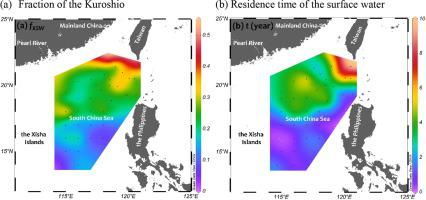Progress in Oceanography ( IF 4.1 ) Pub Date : 2021-06-04 , DOI: 10.1016/j.pocean.2021.102619 Guizhi Wang , Shengyao Sun , Ehui Tan , Liwen Chen , Lifang Wang , Tao Huang , Kuanbo Zhou , Weifang Chen , Xianghui Guo

|
The Kuroshio intrusion through the Luzon Strait into the northern South China Sea (SCS) is an important contributor to the heat and salt budgets of the SCS and is usually the strongest in winter. The extent of the intrusion in summer and the residence time of the very surface layer (0–5 m) in the northern SCS slope and basin areas, however, are seldom quantitatively evaluated. In this study we investigated surface distributions of radium isotopes (226Ra and 228Ra) across the Luzon Strait into the northern SCS in late spring to mid-summer to reveal the fraction of the Kuroshio water and the transport path of the Kuroshio intrusion in the northern SCS. The activity of 228Ra ranged from 0.67 to 23.5 dpm 100 L-1, with the maximum occurring at the lowest salinity of 28.8 on the northern SCS shelf and the minimum appearing east of the Luzon Strait characteristic of the more saline Ra-depleted Kuroshio water. The activity of 226Ra showed a similar pattern in a smaller range of 4.63–9.64 dpm 100 L-1. Distributions of 226Ra and 228Ra, combined with the distribution of salinity, demonstrate that three water masses contribute to the surface seawater in the northern SCS, the Kuroshio surface water, the plume water, and the island-influenced surface water. We quantified the fraction of the Kuroshio water in the northern SCS, considering the conservation of 226Ra and salinity, to be in the range of 4 ± 7%–51 ± 4% with an average of 23 ± 11%. The fraction decreased southward and westward from the northwest off the Luzon Strait. The intrusion of the Kuroshio reached as far west as 115° E and as far south as 14° N. The residence time of the very surface water in the northern SCS slope and basin areas was estimated using 228Ra as a timer to be 0.22 ± 0.59–9.98 ± 0.54 years with an average of 2.92 ± 2.20 years.
中文翻译:

镭同位素揭示夏季黑潮强烈入侵及在南海北部的停留时间
黑潮通过吕宋海峡侵入南海北部(SCS)是南海热盐收支的重要贡献者,通常在冬季最强。然而,很少对南海北部斜坡和盆地地区夏季入侵的程度和表层(0-5 m)的停留时间进行定量评估。在这项研究中,我们调查了晚春至仲夏穿过吕宋海峡进入南海北部的镭同位素(226 Ra 和228 Ra)的表面分布,以揭示黑潮水的比例和黑潮入侵的运输路径。南海北部。228 Ra的活度范围为 0.67 至 23.5 dpm 100 L -1,最大值出现在南海北部陆架的最低盐度 28.8 处,最小值出现在吕宋海峡以东,特征为更咸的 Ra 耗尽黑潮水。226 Ra的活性在 4.63–9.64 dpm 100 L -1的较小范围内显示出类似的模式。的分布226 Ra和228镭,随盐度的分布相结合,表现出三个水团南海北部有助于表面海水,黑潮地表水,羽水,并在岛上影响的地表水。我们量化了南海北部黑潮水的比例,考虑到226Ra 和盐度,在 4 ± 7%–51 ± 4% 的范围内,平均值为 23 ± 11%。比例从吕宋海峡西北部向南和向西减少。黑潮的侵入最远西至东经 115°,南至北纬 14°。南海北部斜坡和盆地地区地表水的停留时间以228 Ra 作为计时器估计为 0.22 ± 0.59–9.98 ± 0.54 年,平均 2.92 ± 2.20 年。



























 京公网安备 11010802027423号
京公网安备 11010802027423号